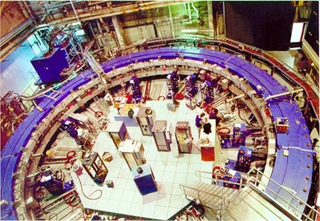
The Muon g-2 Experiment uses the Alternating Gradient Synchrotron (AGS) to deliver a custom muon beam into the world's largest superconducting magnet -- the "muon storage ring" -- pictured above. (Image courtesy of the U.S. Department of Energy's Brookhaven National Laboratory.)
Instructor(s)
Prof. Donald Sadoway
MIT Course Number
3.53
As Taught In
Spring 2001
Level
Graduate
Course Description
Course Features
Course Description
This course covers a variety of topics concerning superconducting magnets, including thermodynamic and transport properties of aqueous and nonaqueous electrolytes, the electrode/electrolyte interface, and the kinetics of electrode processes. It also covers electrochemical characterization with regards to d.c. techniques (controlled potential, controlled current) and a.c. techniques (voltametry and impedance spectroscopy). Applications of the following will also be discussed: electrowinning, electrorefining, electroplating, and electrosynthesis, as well as electrochemical power sources (batteries and fuel cells).


